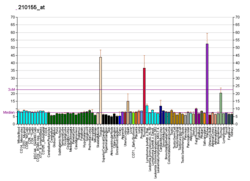Myocilin
Myocilin, trabecular meshwork inducible glucocorticoid response, also known as MYOC, is a protein which in humans is encoded by the MYOC gene.[5][6] Mutations in MYOC are a major cause of glaucoma.
Function
MYOC encodes the protein myocilin. The precise function of myocilin is unknown, but it is normally secreted into the aqueous humor of the eye. MYOC mutations, which cause myocilin to accumulate in the cells of the trabecular meshwork are a common cause of glaucoma. Most MYOC mutations identified in glaucoma patients are heterozygous and are confined to the olfactomedin domain, which is encoded by exon 3.[7]
Myocilin is believed to have a role in cytoskeletal function. MYOC is expressed in many ocular tissues, including the trabecular meshwork, and was revealed to be the trabecular meshwork glucocorticoid-inducible response protein (TIGR). The trabecular meshwork is a specialized eye tissue essential in regulating intraocular pressure, and mutations in MYOC have been identified as the cause of hereditary juvenile-onset open-angle glaucoma.[8]
Clinical significance
MYOC contains a signal sequence for secretion, and is secreted into the aqueous humor of the eye by the trabecular meshwork. Mutations in MYOC are found in 4% of adult-onset primary open-angle glaucoma and >10% of juvenile-onset primary open-angle glaucoma. Overexpression or underexpression of MYOC does not cause glaucoma. However, the MYOC gene also contains a signal sequence, which is normally not functional, that directs intracellular proteins to peroxisomes. Glaucoma-associated mutations activate that signal sequence and direct myocilin to peroxisomes, where they accumulate in the cell, instead of being secreted. Decreased secretion and increased accumulation appear to be the initial steps in myocilin-associated glaucoma.[9]
A study employing iterative pocket & ligand-similarity based approach to virtual ligand screening predicted small molecule binders for the olfactomedin domain of human myocilin. The predictions were subsequently assessed by differential scanning fluorimetry[10].
Interactions
References
- 1 2 3 GRCh38: Ensembl release 89: ENSG00000034971 - Ensembl, May 2017
- 1 2 3 GRCm38: Ensembl release 89: ENSMUSG00000026697 - Ensembl, May 2017
- ↑ "Human PubMed Reference:".
- ↑ "Mouse PubMed Reference:".
- ↑ Stone EM, Fingert JH, Alward WL, Nguyen TD, Polansky JR, Sunden SL, Nishimura D, Clark AF, Nystuen A, Nichols BE, Mackey DA, Ritch R, Kalenak JW, Craven ER, Sheffield VC (January 1997). "Identification of a gene that causes primary open angle glaucoma". Science. 275 (5300): 668–70. doi:10.1126/science.275.5300.668. PMID 9005853.
- ↑ Kubota R, Noda S, Wang Y, Minoshima S, Asakawa S, Kudoh J, Mashima Y, Oguchi Y, Shimizu N (May 1997). "A novel myosin-like protein (myocilin) expressed in the connecting cilium of the photoreceptor: molecular cloning, tissue expression, and chromosomal mapping". Genomics. 41 (3): 360–9. doi:10.1006/geno.1997.4682. PMID 9169133.
- ↑ Ortego J, Escribano J, Coca-Prados M (August 1997). "Cloning and characterization of subtracted cDNAs from a human ciliary body library encoding TIGR, a protein involved in juvenile open angle glaucoma with homology to myosin and olfactomedin". FEBS Letters. 413 (2): 349–53. doi:10.1016/S0014-5793(97)00934-4. PMID 9280311.
- ↑ "Entrez Gene: MYOC myocilin, trabecular meshwork inducible glucocorticoid response".
- ↑ Young H. Kwon, John H. Fingert, Markus H. Kuehn, Wallace L.M. Alward, Primary Open-Angle Glaucoma, N Engl J Med 2009;360:1113-24.
- ↑ Srinivasan B, Tonddast-Navaei S, Skolnick J (September 2017). "Pocket detection and interaction-weighted ligand-similarity search yields novel high-affinity binders for Myocilin-OLF, a protein implicated in glaucoma". Bioorganic & Medicinal Chemistry Letters. 27 (17): 4133–4139. doi:10.1016/j.bmcl.2017.07.035. PMC 5568477. PMID 28739043.
- ↑ Torrado M, Trivedi R, Zinovieva R, Karavanova I, Tomarev SI (May 2002). "Optimedin: a novel olfactomedin-related protein that interacts with myocilin". Human Molecular Genetics. 11 (11): 1291–301. doi:10.1093/hmg/11.11.1291. PMID 12019210.
Further reading
- Fingert JH, Stone EM, Sheffield VC, Alward WL (2003). "Myocilin glaucoma". Survey of Ophthalmology. 47 (6): 547–61. doi:10.1016/S0039-6257(02)00353-3. PMID 12504739.
- Polansky JR (December 2003). "Current perspectives on the TIGR/MYOC gene (Myocilin) and glaucoma". Ophthalmology Clinics of North America. 16 (4): 515–27, v–vi. doi:10.1016/S0896-1549(03)00068-3. PMID 14740993.
- Coca-Prados M, Escribano J (May 2007). "New perspectives in aqueous humor secretion and in glaucoma: the ciliary body as a multifunctional neuroendocrine gland". Progress in Retinal and Eye Research. 26 (3): 239–62. doi:10.1016/j.preteyeres.2007.01.002. PMID 17321191.




